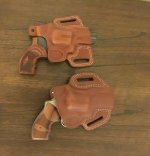others before and after have echoed its general principle; i.e. "slow-burning powders and lightweight bullets"
Slower burning powders combined with lighter bullets seem to be the culprit. The issue doesn't surface at all with 38 special, where a wide range of bullet weights is combined almost exclusively with faster burning powders, albeit at lower pressure/volumes. Nor were cracked forcing cones widely reported "back in the day" when magnum loads as I understand it tended to be hot and heavy. Was it simply that most people obediently practiced exclusively with 38 special and only occasionally shot 357 magnum? I doubt it.
Older editions of reloading manuals famously included max charge powder volumes far in excess of current SAAMI specs and many reloaders complain about the weak recipes typically found in current editions. Ammunition commercially available today is also generally weak compared to the legendary loads of yesteryear. In addition, I'm pretty certain that people shot more cast bullets back then (which normally feature a diameter that is a couple thou over the nominal caliber size and probably do a better job of sealing the chamber throat/barrel). Cylinder timing is probably a major factor, too. If the timing is off, the bullet will be striking the forcing cone off-center, exacerbating the problem. Timing can be easily fixed by a gunsmith (as can end shake), but how many people bother to check it semi-regularly? Also, how many introduce timing issues by modifying the trigger pull? The more I think about it, people shooting their revolvers loose without proper and timely maintenance is probably a major factor contributing to cracked forcing cones on K-frames. It might well be that the forcing cones on L and N-frames are simply robust enough to handle that sort of abuse.
Even back in the 70s/80s when the issue first arose, there wasn't exactly an epidemic of cracked forcing cones. While the issue is no doubt real, I get the sense that people make a bigger deal of it than necessary (much like worrying about the dreaded internal lock possibly engaging at the wrong moment). Regardless, whatever the exact combination of factors causing premature wear and tear of K-frames is, flame-throwing 125 grain magnum JHPs seem to be at the center of it. And it's easy enough to avoid them. The theory of combusting gases getting ahead of short bullets may seem improbable, but it is still the most plausible explanation I've heard so far (other than my thoughts on timing). The idea that S&W stubbornly manufactured inherently weak magnum revolvers for decades seems even more improbable. While I may not intend to baby my 66-2, I honestly don't think the volume of 158+ grain cast bullets that I normally shoot at velocities of around 1000 to 1200 fps is all that punishing – for me or the revolver. I expect that I'll add an L-frame to my small collection long before I wear out my K-frame. Not so much out of concern for my beloved 66-2 as a desire to own a 3" 686.
How does the burning gas which escapes the chamber throat into the barrel AHEAD of the shorter bullet put more wear on the gun than the pressurized burning gas which fills the barrel BEHIND the bullet(regardless of the bullet's length/weight)?
It's my understanding that the magic combination is super hot gases heating the barrel,
followed or coincided by the bullet slamming into the forcing cone. I don't think the fact that the combusting gas behind the bullet are under pressure until the bullet exits the barrel matters much. Otherwise you'd see such excessive wear and tear the whole length of the barrel – especially in pistols, which lack a comparable B/C gap as a sort of pressure relief valve. Although you're probably on to something with the gas escaping through the B/C gap. The gap in my two magnum revolvers happens to be very tight with very little end shake. Clearly, the wider the gap/greater the shake, the more gas escapes, heating up not just the interior surface of the barrel, but the outer surface and face of the forcing cone as well, which surely exacerbates the problem.
For what it's worth, I wouldn't blame anyone for babying their K-frame. Especially considering that S&W no longer has any of the older barrels around for replacement should the forcing cone crack. S&W may not make them like it used to, but at least it made them in large numbers. My 66-2 is a classic, second in my mind only to the legendary 1911 as
the quintessential American handgun. But fortunately it's hardly rare.



